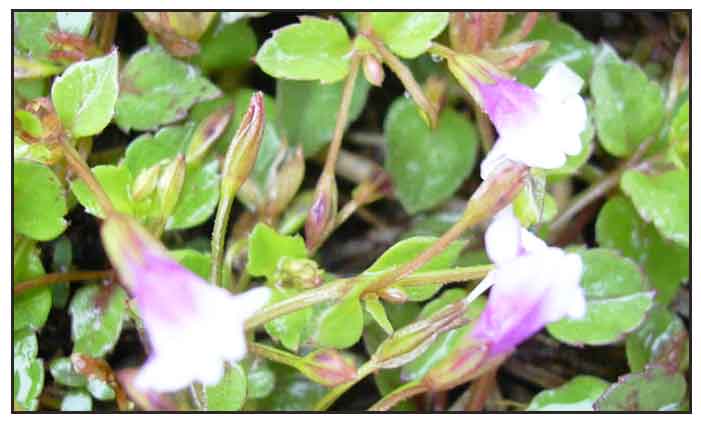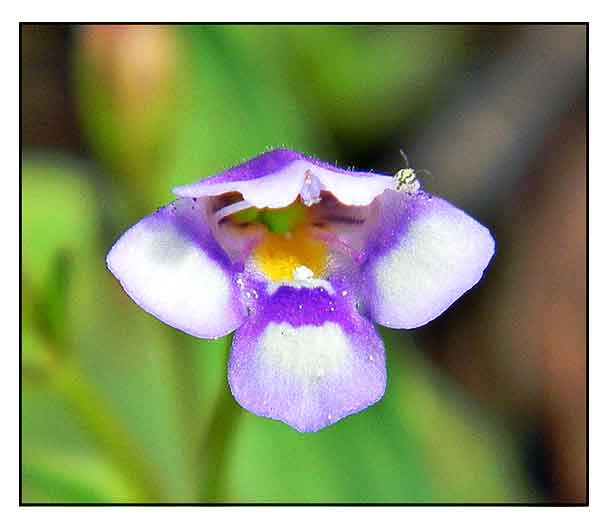
Family • Scrophulariaceae / Linderniaceae
False pimpernel
Lindernia crustacea (L.) F.Muell.
ROUND-FRUITED LINDERNIA
Mu cao
| Scientific names | Common names |
| Antirrhinum hexandrum Forssk. | Brittle false pimpernel (Engl.) |
| Antirrhinum hexandrum G. Forst. | Malaysian false pimpernel (Engl.) |
| Buhnera capillaris Desv. ex Ham. | Round-fruited lindernia (Engl.) |
| Capariaa crustacea L. | |
| Gratiola aspera Roth. | |
| Gratiola lucida Willd. | |
| Hornemannia ovata Link & Otto. Unresolved | |
| Linaria hexandra F. Dietr. Unresolved | |
| Lindernia crustacea (Linn.) F. Muell. | |
| Morgania lucida Spreng. | |
| Lindernia crustacea (L.) F.Muell. is an accepted name. The Plant List | |
| Other vernacular names |
| BANGLADESH: Chapraghash. |
| BRUNEI: Kerak nasi, Ganing. |
| CAMBODIA: Chiek to:k. |
| CHINESE: Mu cao. |
| HIMALAYA: Pitt papadi. |
| INDIA: Katu-pee-tsjanga-puspam. |
| INDONESIAN: Daun sink ketok, Jukut mata heuyeup. |
| JAPANESE: Urikusa. |
| JAVA: Brobos kebo. |
| MALAYSIA: Akar kerak nasi, Akar kelurut, Rumput jari chechak. |
| THAILAND: Yaa kaaphoi tua mia, To ti ke kang. |
| VIETNAM: M[aax]u th[ar]o, Maau thao, D[aa]y l[uw] [owr]i d[oof]ng, Day luoi dong, Tri uong. |
Updated October 2019 / August 2017 / April 2014
![]()
 |
| IMAGE SOURCE: Lindernia crustacea (flowers) / File:Starr 031118-0050 Lindernia crustacea.jpg / Plants of Hawaii / Forest & Kim Starr / 1883 / 18 November 2003 / click on image to go to source page / Creative Commons Attribution / Wikimedia Commons |
| OTHER IMAGE SOURCE: Lindernia crustacea (flower) / Malaysian false pimpernel / Jacopo Werther / crustacea.jpg / CC by SA 2.0 / click on image to go to source page / Wikipedia |
| Additional
Sources and Suggested Readings (1) A review on the medicinal and edible aspects of aquatic and wetland plants of India / Swapna M. M., Prakashkumar R., Anoop K. P., Manju C. N. and Rajith N. P. / Journal of Medicinal Plants Research Vol. 5(33), pp. 7163-7176, 31 December, 2011 (2) Lindernia crustacea (L.) F. Muell. / Vernacular names / GLOBinMED (3) Phytoremediation of Mercury-Contaminated Soil Using Three Wild Plant Species and Its Effect on Maize Growth / N. Muddarisna, B.D. Krisnayanti, S.R. Utami, E. Handayanto / AEES, Vol 1, Issue 3. (4) Ethno-medicinal Plants of the Garhwal Himalaya Used to Cure Various Diseases: A Case Study / L.R Dangwal, Antima Sharma*, C.S Rana / New York Science Journal 2010;3(12) (5) Lindersin B From Lindernia Crustacea Induces Neuritogenesis by Activation of Tyrosine Kinase A/Phosphatidylinositol 3 Kinase/Extracellular Signal-Regulated Kinase Signaling Pathway / L Cheng et al. / Phytomedicine, Jan 2017; 24: pp 31-38 / doi: 10.1016/j.phymed.2016.11.011. (6) Ethno-medicinal Plants of the Garhwal Himalaya Used to Cure Various Diseases: A Case Study / L.R Dangwal, Antima Sharma*, C.S Rana / New York Science Journal 2010; 3(12) (7) Antiproliferative Activity of Vietnamese Medicinal Plants / Jun-ya Ueda, Yasuhiro Tezuka, Shigetoshi Kadota et al. / Biol. Pharm. Bull. 25(6); pp 753-760 (2002 (8) SCIENTIFIC EVIDENCE OF Lindernia crustacea (L) F.MUELL, AN INDIGENOUS PLANT: A FOLKLORE MEDICINE USED TRADITIONALLY / Smriti Rekha Chanda Das , Abdul Baquee Ahmed, Dipankar Saha, Indranil Chanda / International Research Journal of Pharmacy, 2019; 10(1) (9) ISOLATION AND IN VITRO ANTIOXIDANT ACTIVITY OF FLAVONOID FROM LINDERNIA CRUSTACEA (L) F. MUELL / SMRITI REKHA CHANDA DAS, ABDUL BAQUEE AHMED, DIBYENDU SHIL, INDRANIL CHANDA / Asian Journal of Pharmaceutical and Clinical Research, June 2019; 12(6) / https://doi.org/10.22159/ajpcr.2019.v12i6.33344 (10) Lindernia crustacea / Synonyms / The Plant List (11) Medicinal plants used by the Hre community in the Ba to district of central Vietnam / Vo Van Minh, Nguyen Thi Kim Yen, Phạm Thi Kim Thoa / Journal of Medicinal Plants Studies, 2014; 2(3): pp 64-71 (12) Investigation of Anticancer Activity of Lindernia crustacea (L.) F. Muell. var. Crustacean / Sahapat Barusrux,Natthida Weerapreeeyakul, Preeyaporn Plaimee, Munthipia Khamphio et al / Walailak Journal of Science and Technology, 2019; 16(5): pp 307-317 (13) An ethnobotanical survey of antidiabetic medicinal plants used by the Bodo tribe of Kokrajhar district, Assam / Manita Daimari, Mritunjoy Kumar Roy, Ananta Swargiary, Sanjib Baruah & Sanswrang Basumatary / Indian Journal of Traditional Knowledge, July 2019;18(3): pp 421-429 |
| It is not uncommon for links on studies/sources to change. Copying and pasting the information on the search window or using the DOI (if available) will often redirect to the new link page. (Citing and Using a (DOI) Digital Object Identifier) |
• |
 |


 Uses
Uses 